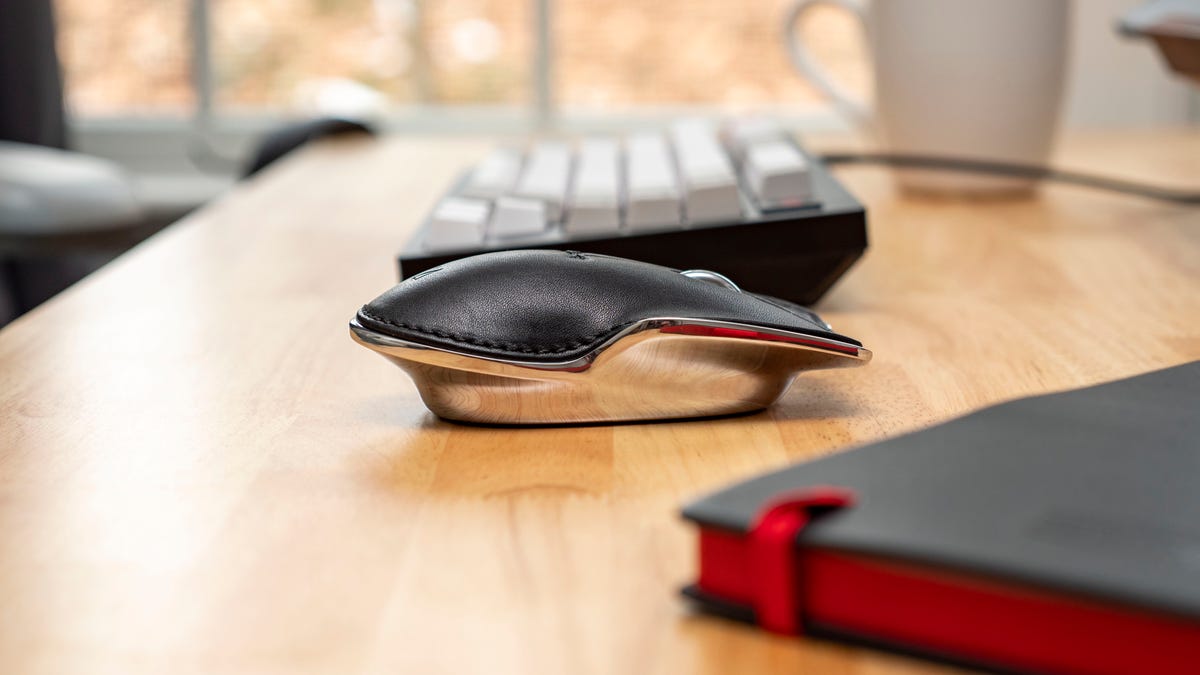 Why You Can Trust CNET
Why You Can Trust CNET Lunar Artefacts' $250 mouse could be the last you ever buy
The wireless Pointer Instrument is not only made from high-quality materials but is completely user-repairable.

Lunar Artefacts' Pointer Instrument is like no computer mouse I've ever seen or used. The company says it took its design inspirations from "the artistry of automotive lines, from the haunches of a Corvette Stingray to the intake scoops of a Lotus 72D." The shape of the mouse is only one part of what makes it so interesting, though.
The company made its mouse as a response to mainstream electronics that are made mostly from plastic, can't be easily repaired and are designed for planned obsolescence. The Pointer Instrument is built to essentially be the last mouse you'll ever need.
The mouse is two pieces, a solid metal shell with all the components inside and a removable leather top cover (you can get it in translucent plastic as well). The shell is made from hand-polished brass or aluminum (I tested the latter). This gives you two weight options: 200 grams for the brass, 125 grams for the aluminum. The aluminum model is a comfortable weight that makes it easy to slide around on your desk and to pick up while mousing.
It's an unusual shape but, in the end, quite comfortable.
The sculpted shell is ambidextrous and there are no buttons on the sides, only the two main ones and another when you press down on the scroll wheel. Since it is not your typical mouse shape, it might take a few days or more to adjust and get comfortable. But, if you like the mouse but wish it had a more traditional shape, the company makes special grips that attach to do just that. The smooth metal scroll wheel was the only thing I wasn't crazy about; it doesn't have the same grip as the knurled wheels on other mice. It's a quibble given how excellent the rest of the mouse is.
The mouse. can be charged with its USB-C cable or on a Qi wireless charger.
The removable cover is cut from full-grain calf leather finished with equestrian-inspired stitching. Both the shell and cover are designed to wear and patina over time and get more attractive as opposed to the average plastic mouse that typically looks worn and dirty after years of use.
Also read: Best mouse for 2022
Lunar Artefacts used a Pixart PAW 3805 optical sensor that works on almost any surface, including glass or mirrors. A button on the bottom lets you choose the pointer sensitivity setting: 800, 1,200, 2,000 or 3,000dpi. That is sensitive enough for most people's needs, especially for work, giving you both speed and precision. Although for gaming, depending on your display size and resolution, your playing style and the games you're playing, a dedicated gaming mouse might be a better option.
The USB-A wireless adapter stores in the base.
The Pointer Instrument can connect wirelessly over Bluetooth 5.0 or 2.4GHz wireless with the USB-A adapter that is stored in the base when not in use. It can also be used wired with the braided USB-C-to-USB-A cable included, which also charges the mouse. The mouse has Qi wireless charging, too, so it's easy enough to keep the battery topped off.
The mouse's USB-C port is tucked under the mouse buttons in front.
So with this mouse, you're getting wired and dual-wireless connection options, wired and wireless charging and an optical sensor with adjustable sensitivity and that works on glass surfaces, and it's all built in a beautifully sculpted solid metal shell with a durable leather top cover. While all of that is great, there's nothing to stop parts from failing or the internal rechargeable battery from no longer holding a charge someday. Lunar Artefacts solved this by making the mouse completely user-repairable.
Two small screws on the top cover let you adjust the feel of the mouse buttons.
Pop the cover off (it hooks into the body at the front and is attached with a magnet at the back) and remove a handful of screws and it can be completely disassembled right down to the plug-and-play Omron switches. (Check out a rebuild walkthrough video for the mouse to see just how easy it can be serviced.) Every part can be replaced or presumably upgraded later.
At $259 (AU$355, £185) for the aluminum model, the Lunar Artefacts Pointer Instrument is no doubt expensive. But, considering the materials used, the capabilities of the mouse and that it's repairable, you're getting your money's worth. And that includes lifetime repair service, too.

